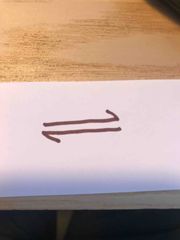![]()
![]()
![]()
Use LEFT and RIGHT arrow keys to navigate between flashcards;
Use UP and DOWN arrow keys to flip the card;
H to show hint;
A reads text to speech;
31 Cards in this Set
- Front
- Back
|
what is the symbol for a reversible reaction |

this |
|
|
what is a reversible reaction |
a reaction where the products react to make the reactants |
|
|
what is meant by the term dynamic equilibrium |
a reaction where —the forwards reaction rate is the same as the backwards — as a result there is no net change in the concentration of reactants and products |
|
|
state the conditions of the Haber process (3) |
•450°C •200 atm pressure •Fe catalyst |
|
|
write the balanced equation for the reaction in the Haber process |
3H(2)+N(2)<=>2NH(3) |
|
|
what are the raw materials in the Haber process? |
air (for nitrogen) and Methane/Natural gas (for hydrogen) |
|
|
what do fertilisers do |
Increase the growth of plants |
|
|
which elements do fertilisers contain |
NPK N- nitrogen P- phosphorus K- potassium |
|
|
why do fertilisers contain nitrogen, phosphorus and potassium |
they promote plant growth (and improve crop yield) |
|
|
what salt is made when ammonia reacts with nitric acid |
ammonium nitrate |
|
|
what salt is made when ammonia reacts with sulfuric acid |
ammonium sulfate |
|
|
write the formulae for: A) hydrogen (gas) B) nitrogen (gas) C) ammonia (gas) D) AmmoniUM (ion) E) nitric acid F) sulfuric acid |
A) H(2) B) N(2) C) NH(3) D) NH(4)+ E) HNO(3) F) H(2)SO(4) |
|
|
explain the term ‘exothermic’ |
a reaction that gives heat out to the surroundings |
|
|
explain the term ‘endothermic’ |
a reaction that takes in heat from the surroundings |
|
|
state and explain the effect of increasing TEMPERATURE on a reaction at equilibrium |
it will move in the endothermic direction |
|
|
state and explain the effect on decreasing temperature on a reaction at equilibrium |
it will move in the exothermic direction |
|
|
state and explain the effect on increasing the pressure on a reaction at equilibrium |
it will move in the direction that produces fewer moles |
|
|
state and explain the effect on decreasing the pressure on a reaction at equilibrium |
it will move in the direction that produces more moles of gas |
|
|
state and explain the effect of a catalyst on the yield of a reaction at equilibrium |
NONE a catalyst doesn’t effect the position of equilibrium |
|
|
how do you find percentage yield? |
(actual yield/ theoretical yield) X100 |
|
|
how do you find the theoretical yield |
mass= moles x Ar |
|
|
why do farmers use fertiliser |
to supply the plants with NPK which are the elements necessary for amino acids to enable growth and increase crop yield |
|
|
which two reactants do you need to make ammonium sulfate |
ammonia and sulfuric acid |
|
|
why might methods in a lab to make a salt be unsuitable for industrial scale production |
batch process- as the measuring equipment would be too small and the process would have to keep repeating, which is energy and labour intensive |
|
|
what are the solubility rules |
-all common salts are soluble -all nitrates are soluble -common chlorides are soluble except those of silver or lead |
|
|
write a balanced symbol equation between ammonia solution and an acid to make ammonium sulphate |
NH(4)+H(2)SO(4)-[NH(4)](2)SO(4) |
|
|
what is the main use of ammonium sulfate |
making fertilisers |
|
|
what does the term element mean |
a substance that is made from only one type of atom |
|
|
what is the source of nitrogen |
the air |
|
|
what is the source of hydrogen |
natural gas or fossil fuels |
|
|
why does increasing the pressure increase the chance of molecules of hydrogen and nitrogen texting together |
as there are more reactant particles for a given volume, increasing reaction rate |

